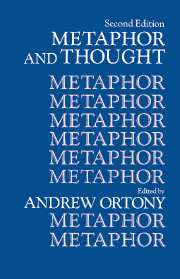Book contents
- Frontmatter
- Contents
- List of contributors
- Preface to the second edition
- Preface to the first edition
- 1 Metaphor, language, and thought
- METAPHOR AND MEANING
- METAPHOR AND REPRESENTATION
- 9 Generative metaphor: A perspective on problem-setting in social policy
- 10 The conduit metaphor: A case of frame conflict in our language about language
- 11 The contemporary theory of metaphor
- 12 Process and products in making sense of tropes
- 13 Metaphor, induction, and social policy: The convergence of macroscopic and microscopic views
- METAPHOR AND UNDERSTANDING
- METAPHOR AND SCIENCE
- METAPHOR AND EDUCATION
- References
- Author index
- Subject index
9 - Generative metaphor: A perspective on problem-setting in social policy
Published online by Cambridge University Press: 05 June 2012
- Frontmatter
- Contents
- List of contributors
- Preface to the second edition
- Preface to the first edition
- 1 Metaphor, language, and thought
- METAPHOR AND MEANING
- METAPHOR AND REPRESENTATION
- 9 Generative metaphor: A perspective on problem-setting in social policy
- 10 The conduit metaphor: A case of frame conflict in our language about language
- 11 The contemporary theory of metaphor
- 12 Process and products in making sense of tropes
- 13 Metaphor, induction, and social policy: The convergence of macroscopic and microscopic views
- METAPHOR AND UNDERSTANDING
- METAPHOR AND SCIENCE
- METAPHOR AND EDUCATION
- References
- Author index
- Subject index
Summary
Introduction
Much of the interest in metaphor on the part of linguists and philosophers of language has had to do with metaphor as a species of figurative language which needs explaining, or explaining away. (See, for a notable example, Searle, this volume. Two classic articles, Black, 1962b, and Beardsley, 1967, are also in this vein.) Metaphor, in this tradition, is a kind of anomaly of language, one which must be dispelled in order to clear the path for a general theory of reference or meaning. There is a very different tradition associated with the notion of metaphor, however – one which treats metaphor as central to the task of accounting for our perspectives on the world: how we think about things, make sense of reality, and set the problems we later try to solve. In this second sense, “metaphor” refers both to a certain kind of product – a perspective or frame, a way of looking at things – and to a certain kind of process – a process by which new perspectives on the world come into existence. In this tradition, metaphorical utterances – “Man is a wolf” along with the rest of the rather dreary repertoire of hallowed examples – are significant only as symptoms of a particular kind of seeing-as, the “meta-pherein” or “carrying over” of frames or perspectives from one domain of experience to another. This is the process which, in the remainder of this paper, I shall call generative metaphor.
- Type
- Chapter
- Information
- Metaphor and Thought , pp. 137 - 163Publisher: Cambridge University PressPrint publication year: 1993
- 281
- Cited by



